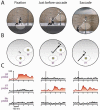Spatial remapping of the visual world across saccades
- PMID: 17632269
- PMCID: PMC2531238
- DOI: 10.1097/WNR.0b013e328244e6c3
Spatial remapping of the visual world across saccades
Abstract
Recent research has identified neurons in the visual system that remap their receptive fields before a saccade. The activity of these neurons may signal a prediction of postsaccadic visual input, derived from an efference copy of saccadic motor output. Such a prediction is often thought to underlie our perception of a stable visual world, by compensating for the shifts in retinal image that accompany each eye movement. Here we review the evidence, and conclude that prediction does not in fact play a significant role in maintaining visual stability. Instead, we consider a novel perspective in which the primary function of spatial remapping is to support three key nonperceptual processes: action control, sensorimotor adaptation and spatial memory.
Figures





References
-
- von Holst E, Mittelstaedt H. Das Reafferenzprincip. Naturwissenschaft. 1950;37:464–476.
-
- Sperry RW. Neural basis of the spontaneous optokinetic response produced by visual inversion. J Comp Physiol Psychol. 1950;32:482–489. - PubMed
-
- Duhamel JR, Colby CL, Goldberg ME. The updating of the representation of visual space in parietal cortex by intended eye movements. Science. 1992;255(5040):90–92. - PubMed
-
- Colby CL, Goldberg ME. Space and attention in parietal cortex. Annu Rev Neurosci. 1999;22:319–349. - PubMed
-
- Sommer MA, Wurtz RH. Influence of the thalamus on spatial visual processing in frontal cortex. Nature. 2006;444(7117):374–377. - PubMed
Publication types
MeSH terms
Grants and funding
LinkOut - more resources
Full Text Sources

